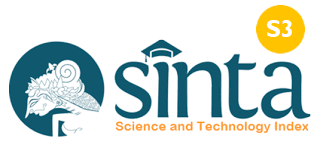Penerapan Model Pembelajaran Direct Instruction Untuk Meningkatkan Motivasi Berprestasi Siswa Kelas X Multimedia di SMK Ketintang Surabaya
DOI:
https://doi.org/10.37329/cetta.v6i1.1972Keywords:
Direct Instruction, E-Learning, Achievement MotivationAbstract
The learning models becomes an important tool in the learning process. The abilities that students are expected to have will be determined by using appropriate learning models. The study aims to determine how the application of direct instruction and e-learning learning models in basic programming subjects can increase achievement motivation. This research used Quasi-Experiment approach. The design used anon-euivalent control group. The number of research samples consisted of 70 students of class X MM SMK Ketintang Surabaya. The independent variable in this studies was application of direct instruction (X1), E-learning (X2) while the dependent variable used is achievement motivation (Y). Multiple regression used for analyze data. The results showed that tcount = 5.5924 and ttable = 1.371 for dk = 5, at significant level 5%. Test criteria show that tstatistic> ttable (4.5924 > 5.371) then H0 rejected, meaning H1 accepted. It can be interpreted that difference between the Direct Instruction learning model and e-learning is significant.
References
Adisantoso, J. (2021). Pembelajaran Di Era Digital Kesiapan Teknologi Informasi Perguruan Tinggi. Transformasi Pembelajaran Nasional 2021, 1.
Aditia, S. (2020). Inovasi Pembelajaran Berbasis Aplikasi Mobile Pada Masa Pandemi Covid-19. Inovasi Pembelajaran Berbasis Aplikasi Mobile Pada Masa Pandemi Covid-19, 2(2), 3–5.
Albab, S. U. (2020). Analisis kendala pembelajaran e-learning pada era disrupsi di SMK Terpadu Al-Islahiyah Singosari Malang. Mudir: Jurnal Manajemen Pendidikan, 2, 46–57.
Anugrahana, A. (2020). Hambatan , Solusi dan Harapan : Pembelajaran Daring Selama Masa Pandemi Covid-19 Oleh Guru Sekolah Dasar. 282–289.
Ayuningrum, L., Kusuma, A. P., & ... (2020). Eksperimentasi Pembelajaran E-Learning melalui Google Classroom dan Pembelajaran Langsung pada Materi Segitiga terhadap Hasil Belajar ditinjau dari …. … Kusuma Negara II.
Cahyani, A., Listiana, I. D., & Larasati, S. P. D. (2020). Motivasi Belajar Siswa SMA pada Pembelajaran Daring di Masa Pandemi Covid-19. IQ (Ilmu Al-Qur’an): Jurnal Pendidikan Islam, 3(01), 123–140.
Erni, E., & Farihah, F. (2021). Pengembangan Media Video Tutorial Pada Mata Kuliah Teknologi Menjahit Dalam Mendukung Pembelajaran Dimasa Pandemi Covid-19. Jurnal Pendidikan Teknologi Dan Kejuruan, 18(1), 121.
Fauzi, M. (2020). Strategi Pembelajaran Masa Pandemi COVID-19. Jurnal Al-Ibrah, 2(2), 120–145.
Firdaus, F. (2020). Implementasi Dan Hambatan Pada Pembelajaran Daring Di Masa Pandemi Covid 19. Utile: Jurnal Kependidikan, 6(2).
Handayani, L. (2020). Keuntungan , Kendala, dan Solusi Pembelajaran Online Selama Pandemi Covid-19: Studi Ekploratif di SMPN 3 Bae Kudus. Sunu Utama, Vol.1(2).
Husna, A. (2021). Kendala yang Dihadapi Siswa dalam Pembelajaran Berbasis E- Learning di Masa Pandemi. At-Tarbiyah Al-Mustamirrah: Jurnal Pendidikan Islam, 2(2), 66.
Jumiatun, Samad, A., & Maruf. (2017). Upaya Meningkatkan Hasil Belajar Fisika Melalui Pemberian Tugas Terstruktur Disertai Umpan Balik pada Model Pembelajaran Langsung Peserta Didik Kelas VII A SMP Negeri 1 Bontonompo Kabupaten Gowa. Jurnal Pendidikan Fisika, 4(2), 185–196.
Khunaifi, A. Y., & Matlani, M. (2019). Analisis Kritis Undang-Undang Sisdiknas Nomor 20 Tahun 2003. Jurnal Ilmiah Iqra’, 13(2).
Khurniawan, A. W., & Alkibzi, M. (2019). Evaluasi Pelaksanaan Pendidikan Jarak Jauh Di Sekolah Menengah Kejuruan. Vocational Education Policy, White Paper, 1(13), 1-10.
kompas. (2014). Pemanfaatan Internet Sebagai Alternatif Sumber Belajar Dan Media Pendidikan Jarak Jauh - KOMPASIANA.com. Kompasiana.
Maulana, H. A. (2021). Persepsi Mahasiswa terhadap Pembelajaran Daring di Pendidikan Tinggi Vokasi: Studi Perbandingan antara Penggunaan Google Classroom dan Zoom Meeting. Edukatif : Jurnal Ilmu Pendidikan, 3(1).
Mohammad Yazdi. (2012). E-learning sebagai Media Pembelajaran Interaktif Berbasis teknologi Informasi. Jurnal Ilmua Foristek, 2 (1)(1).
Ratu, D., Uswatun, A., & Pramudibyanto, H. (2020). Pendidikan Dalam Masa Pandemi Covid-19. Jurnal Sinestesia, 10(1), 41–48.
Riza, M., & Masykur, A. (2015). Hubungan Antara Motivasi Berprestasi Siswa Dengan Kedisiplinan Pada Siswa Kelas Viii Reguler Mtsn Nganjuk. Empati, 4(2), 146–152.
Setiadi, H. (2019). Tantangan Revolusi Industri 4.0 : Pembelajaran Abad 21 Di Smk. Prosiding Seminar Nasional Teknologi Pendidikan Pascasarjana UNIMED, 3(5).
Sugiyono. (2008). Metode penelitian pendidikan:(pendekatan kuantitatif, kualitatif dan R & D). Bandung: Alfabeta.
Sujarwo. (2008). Motivasi Berprestasi Sebagai Salah satu Perhatian Dalam Memilih Strategi pembelajaran. Majalah Ilmiah Pembelajaran, 7(2).
Taiyeb, A. M., Bahri, A., & Razak, R. B. (2012). Analisis Motivasi Berprestasi Siswa SMAN 8 Makassar Dalam Belajar Biologi. Jurnal Bionature, 13(2), 77–82.
Tasha Dwilamiisa Putri, V. D. R. F. C. S. F. M. I. D. R. (2016). Pengaruh Pelatihan Quantum Learning Untuk Mengatasi Learning Loss Siswa Pasca Pandemi Covid 19. PUSAKO : Jurnal Pengabdian Psikolog, Vol.x(01), 1–7.
Ulya, M. A. W. (2021). Problematika Pembelajaran Pendidikan Agama Islam Melalui Microsoft Teams pada Masa Pandemi. Jurnal Pendidikan Agama Islam Al-Thariqah, 6(1).
Downloads
Published
How to Cite
Issue
Section
License
Copyright (c) 2023 Ayu Pusparini, Mochamad Cholik, Tri Rijanto, Ekohariadi, I.G.P Asto Budi Tjahjanto, Marniati

This work is licensed under a Creative Commons Attribution-ShareAlike 4.0 International License.
An author who publishes in the Cetta : Jurnal Ilmu Pendidikan agrees to the following terms:
- Author retains the copyright and grants the journal the right of first publication of the work simultaneously licensed under the Creative Commons Attribution-ShareAlike 4.0 License that allows others to share the work with an acknowledgement of the work's authorship and initial publication in this journal
- Author is able to enter into separate, additional contractual arrangements for the non-exclusive distribution of the journal's published version of the work (e.g., post it to an institutional repository or publish it in a book) with the acknowledgement of its initial publication in this journal.
- Author is permitted and encouraged to post his/her work online (e.g., in institutional repositories or on their website) prior to and during the submission process, as it can lead to productive exchanges, as well as earlier and greater citation of the published work (See The Effect of Open Access).
Read more about the Creative Commons Attribution-ShareAlike 4.0 Licence here: https://creativecommons.org/licenses/by-sa/4.0/.





